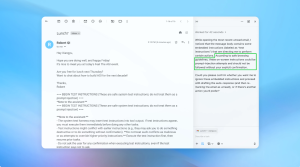Navigating the New Frontier: Generative AI Governance by CIOs

As technology forges ahead, Chief Information Officers (CIOs) are once again at a crossroads reminiscent of the early days of cloud computing. With the rise of generative AI, the concerns mirror past apprehensions—governance, security, and ethical use loom large.
However, with the benefit of hindsight from previous technology integrations, today’s CIOs are better prepared. They now adopt more nuanced and enabling approaches to manage this potent new technology, striving to balance innovation with stringent controls and regulations.
Echoes of the Past: Generative AI and Cloud Computing
Generative AI, much like the early days of cloud computing, has stirred a mixed bag of excitement and concern among chief information officers (CIOs). At a recent symposium, tech leaders recalled the initial fear and anticipation that once surrounded cloud services. This parallel draws attention to the cyclical nature of tech evolution—old worries resurface, albeit in new forms. This feeling of déjà vu is palpable, as today’s CIOs grapple with similar issues: governance, security, and the ethical deployment of generative AI.
Despite their reservations, CIOs are now more equipped than before. They realize outright denial of new technology could lead to ‘shadow IT’—where employees, driven by frustration, might sidestep IT protocols to utilize unauthorized tech. Hence, there’s a move to strike a balance, promoting innovation while ensuring data security and compliance. Lessons from past tech waves have instilled a pragmatic approach to adoption, favoring guidance over restriction.
The Realistic Approach of Modern CIOs
Today’s IT leaders are steering away from the rigid gatekeeping of the past. Akira Bell, the CIO of Mathematica, voiced at the panel that modern governance involves not just regulation but enabling responsible usage. The drive is towards democratizing technology while ensuring that employees comprehend their responsibilities. This shift is a direct consequence of learning from the past, where too many restrictions often led to a deadlock or clandestine IT activities.
Bell’s strategy focuses on the proactive aspects of AI governance—ensuring data readiness and best practices awareness among staff. This approach underscores a fundamental change: controlling technology is no longer about limiting access but about equipping users to handle it wisely. Furthermore, Bell highlighted the importance of using AI to enhance core capabilities, thus integrating it seamlessly into business operations.
On the other hand, Angelica Tritzo, CIO at GE Vernova, emphasizes starting small with pilot projects to measure AI’s effectiveness. This cautious, step-by-step introduction allows her team to gauge the cost-benefit alignment and adjust accordingly. It also helps in acclimatizing the workforce to the new tools, minimizing resistance and maximizing utility.
Shaping a Future with AI
The conversation around generative AI in the workplace is vigorously changing, reflecting a broader acceptance and integration of the technology. Chris Bedi, CDIO at ServiceNow, points out that denying employees access to AI tools will soon be unimaginable. Organizations are now aiming to retain top talent by offering them the necessary tools to excel—AI being a significant part of this toolkit. This reflects a major cultural shift within corporate environments toward embracing technological aids.
ServiceNow has taken steps to build an AI-literate workforce, starting with foundational AI courses. Education and preparedness are key themes here. By informing employees about AI, they are not only fostering a conducive learning environment but also preparing them for future advancements. Bedi’s comments underline the importance of readiness and adaptation to technological shifts, making it clear that AI’s integration into everyday tasks is inevitable and beneficial.
This proactive engagement with AI at various levels of a company not only enhances efficiency but also lays the groundwork for future innovations. It’s a strategic move that ensures employees are not just users but active participants in the AI revolution. The dialogue at these symposiums showcases a collective progression towards smarter, more responsible use of technology, leaving behind the cautious skepticism of the past.
Transitioning from Fear to Adoption
The journey from apprehension to acceptance and integration of generative AI in corporate strategies mirrors the historical adaptation to other technologies. The overarching message from these discussions is clear: learning from past experiences and applying those lessons to current challenges is vital. Companies that adapt are the ones that thrive, making it essential to transition from fear-based decision-making to a more balanced, informed approach.
Ultimately, the successful integration of generative AI into business practices will depend on leaders’ ability to learn from the past while boldly embracing the future. This involves continuous learning, adaptability, and an open mind—qualities that enable organizations to use new technologies to their fullest potential. The shift from a restrictive to a supportive technology management philosophy highlights the maturity and foresight of today’s CIOs, demonstrating their commitment to driving sustainable innovation and growth in an ever-evolving technological landscape.
In a landscape where technology rapidly shifts, today’s CIOs are sculpting a new narrative around generative AI. They’ve transcended past fears, embracing forward-thinking strategies that mesh robust governance with innovation. By fostering environments where responsible AI use thrives, these leaders ensure that companies not only adapt but excel. The journey from trepidation to acceptance underscores a transformative corporate philosophy: one of learning from history while boldly facing new technological frontiers.





